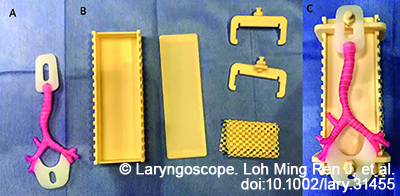
Figure 2. Slide tracheoplasty training model. (A) The 3D reconstructed airway model with flanges to attach to the box trainer. (B) Trainer disassembled, the holders can be adjusted to pull the airway together for the slide portion of the simulation. (C) Final simulation model in the box trainer.
For models used for surgical simulation, additional loops are added at the distal and proximal airways to allow for fitting into a 3D model holder (Fig. 4). They are printed in a combination of Agilus and Vero White to achieve a hardness of Shore 80A for both support and flexibility. The adjustable 3D model holder was designed in computer-aided design (CAD) software and is printed in acrylonitrile styrene acrylate (ASA) filament on a F370 printer (Stratasys, Rehovot, Israel). The model holders are used to hold the trachea models in a realistic orientation for surgery during simulation and to store simulation equipment (scissors, needle driver, forceps) in between simulations. Several different types of pediatric airway pathology can be printed for surgical simulation.
Explore This Issue
July 2024CONCLUSION
This protocol describes the method for creating 3D-printed trachea models for use in high-fidelity simulation-based training and advanced surgical planning for pediatric patients undergoing slide tracheoplasty. The goal is to provide a methodology to allow for replicability and more widespread dissemination of these models to improve clinical training and patient care.